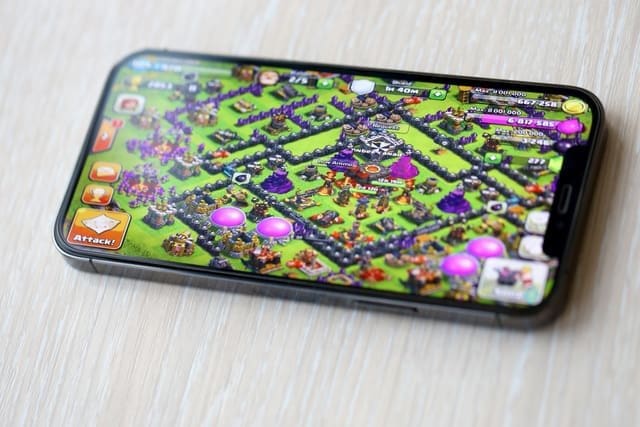MOBA games started as a simple mod for Warcraft III called Defense of the Ancients (DotA). Today, this genre stands as one of gaming’s most influential categories.
League of Legends, which launched in 2009, has grown to over 100 million monthly active players. This makes it the largest multiplayer online battle arena worldwide. Games like Dota 2 rank among the world’s most complex games that demand thousands of hours to master.
The MOBA genre has transformed from PC-exclusive titles to smartphone games. Mobile Legends: Bang Bang and Honor of Kings now bring the complete three-lane strategy experience to your pocket. These games might look daunting at first, but I’ll help you understand everything you need – from simple mechanics to team strategies.
Let me guide you through the world of online battle arenas. You’ll learn about roles, gameplay elements, and valuable tips that will transform you from a newcomer into a competitive player.
What is a MOBA game?

MOBA stands for Multiplayer Online Battle Arena, a competitive genre where two teams of players control individual characters with unique abilities. Players battle to destroy their opponent’s main structure while defending their own. These games blend elements of real-time strategy, role-playing, and action games into a distinct gaming style, unlike traditional strategy games that focus on player-versus-player combat.
How the genre started and evolved
The MOBA experience started in the late 1990s when a modder named Aeon64 created “Eon of Strife,” a custom map for StarCraft. This innovative mod became the foundation for the genre. It featured four players who each controlled a single powerful unit against computer-controlled opponents.
In spite of that, the genre took its true form in 2003 when a map editor named Eul created “Defense of the Ancients” (DotA) for Warcraft III. This mod reshaped the scene by introducing player-versus-player team battles, five-player teams, and hero leveling systems. Steve “Guinsoo” Feak later created DotA Allstars, which combined elements from multiple DotA variations and quickly became the most popular version.
Riot Games coined the term “MOBA” in 2009 to describe their groundbreaking title League of Legends. These games were known earlier by various names including “DotA-style,” “action real-time strategy,” or simply “AoS” after Eon of Strife.
The MOBA floodgates opened by 2010. S2 Games launched Heroes of Newerth, while Valve hired original DotA modders to create Dota 2. Blizzard started developing what would later become Heroes of the Storm. League of Legends now has over 27 million daily players with a concurrent population of 7.5 million.
Key features of multiplayer online battle arenas
MOBAs have several defining characteristics that set them apart from other strategy video games:
- Team-based gameplay: Typically featuring 5v5 matches where coordination is essential
- Single hero control: Each player manages one character with unique abilities rather than an army
- Three-lane map structure: Battlefields divided into pathways connecting opposing bases
- Tower defenses: Automated structures protecting lanes and bases
- Minions/Creeps: AI-controlled units that march down lanes, providing experience and gold
- Character progression: Heroes level up during matches, gaining stronger abilities
- Economy management: Players earn gold to purchase items enhancing their heroes
- Jungle areas: Spaces between lanes containing neutral monsters that provide bonuses
MOBAs put teamwork above everything else. Skilled opponents will defeat any single player trying to carry an incompetent team. This focus on cooperation, combined with high skill ceilings and strategic depth, has made MOBAs dominant in esports, with prize pools reaching over $60 million in 2018.
MOBAs have managed to keep their popularity because they are accessible—most titles are free-to-play and run on modest hardware. The condensed gameplay loop gives players rewarding experiences in shorter time frames than traditional MMORPGs. This makes them ideal for players who want strategic depth without long time commitments.
Understanding the game map and objectives

MOBA games feature unique battlefields that shape match outcomes. The layout of this virtual terrain holds the key to mastering the game.
The three-lane map explained
A typical MOBA battlefield has three main paths called lanes connecting team bases. These lanes—top, middle, and bottom—act as primary routes for strategic advancement. The top lane (or “Baron Lane”) sits next to powerful neutral monsters like Baron Nashor that give team buffs after defeat. Middle lane creates the shortest path between bases and attracts early fights naturally. The bottom lane (“Dragon Lane”) becomes crucial due to dragon objectives that grant special buffs.
The “jungle” fills the space between lanes with neutral monsters. Players can defeat these creatures to earn gold, experience, and powerful buffs. A river cuts through the map diagonally and lets players move between lanes quickly.
What are towers, creeps, and the Nexus?
Each lane has defensive structures called towers (or turrets) that attack enemies who come too close. Players must destroy these protective sentinels one by one to reach the enemy base.
Computer-controlled units called creeps (or minions) emerge from bases and march down lanes regularly. These units give players gold and experience points needed to grow stronger during matches.
The Nexus (or Ancient/Core depending on the game) stands at each base’s center. Teams must guard this vital structure because its destruction means instant defeat.
How teams win a match
The main goal in MOBA games remains simple: destroy the enemy Nexus before they destroy yours. Teams need strategic coordination to achieve this goal.
Good teams destroy towers step by step to build pressure in lanes. Breaking inhibitors (special structures near enemy base) makes your minions stronger and increases their numbers.
Neutral objectives like Baron Nashor, Dragon, or Roshan give powerful advantages that can help break enemy defenses. These buffs often determine which team pushes through to victory.
Teams must balance lane pressure, objective control, and coordination to win matches.
Roles and strategies in a MOBA team

MOBA teams succeed when players know their specific roles and how they work together on the battlefield. Playing these games casually differs from becoming skilled at multiplayer online battle arenas where you need clear role definitions and team coordination.
Tank, Support, Carry, and more
Carry players begin weak but grow into powerhouses late in the game. They rely on their team to help them through early phases so they can collect items and lead the team to victory later. These heroes deal consistent damage but stay vulnerable throughout the match.
Tank/Initiator heroes soak up enemy damage and disrupt opponents to create safe openings for their allies. These characters usually have multiple stun abilities and large health pools, which makes them hard to ignore during team fights.
Support characters shine when they stay close to teammates. Their abilities heal, shield, and strengthen allies. The support’s job includes placing vision wards across the map. They often manage with few items so carries can get more resources.
Jungler heroes farm neutral monsters instead of lane creeps. They help the whole team by launching surprise attacks (ganks) on lanes. Good junglers keep up with their teammates’ experience without taking lane resources.
Other specialized roles include Assassin/Ganker (burst damage specialists), Pusher (lane clearers), and Mage (ability-focused damage dealers).
How team composition affects gameplay
The right team composition substantially affects your chances of winning. A good mix of roles creates synergy that builds on strengths while covering weaknesses. Teams often win or lose during character selection, as poor compositions face huge disadvantages whatever the player skill level.
Winning teams balance damage types (physical and magical) so opponents can’t just build one type of defense. A mix of crowd control, sustain, and damage output creates well-rounded fighting abilities.
Simple strategy for each role
Carries should focus on safe farming and avoid unnecessary risks until they get key items. Tanks must coordinate attacks with their team – starting fights without backup leads to certain death. Support players need to control vision while helping carries through protection and setup. Junglers should secure neutral objectives and create pressure through smart ganks, especially when helping struggling lanes.
These roles and how they work together are the foundations of competitive MOBA success.
How to improve and become a better player

Getting good at multiplayer online battle arenas takes dedication and makes you think over your practice. Your skills won’t improve overnight—it’s an experience of constant learning and adapting.
Learning from losses and watching replays
The ranked climb in MOBA games has its highs and lows. These tough matches teach us the most valuable lessons. Defeats show us the weak spots in our gameplay that wins might hide. Take time to analyze your mistakes instead of getting frustrated after losses.
Reviewing your own gameplay recordings works best to improve. You can spot positioning errors, missed chances, and poor decisions that weren’t clear during the match by watching replays. You can also learn from pro players’ VODs to compare their choices with yours and use their strategies.
Mastering one hero before expanding
It makes sense to try different roles when you start learning a MOBA game. All the same, focusing on one main role helps you build good habits without switching your mechanics and mindset too often.
Players who stick to one champion (“one-trick ponies” or OTPs) climb ranks faster because they really understand what they can do with their hero. New players should practice in the Practice Tool and normal games before taking their hero into ranked matches.
Using in-game communication effectively
Good communication helps teams overcome the challenges of playing with random teammates. Clear communication can make the difference between winning and losing in team-based MOBAs.
The game gives you chat, pings, and voice options to coordinate strategies right away. Just note that toxic behavior hurts team performance. Keep your calls clear and brief, stay positive after setbacks, and praise your teammates’ good plays.
Joining ranked matches and tournaments
Ranked play teaches you more than casual games, even though it’s harder. The ranked progression system tracks your matchmaking rating to show your skill level.
You’ll improve faster by joining a gaming community. You can learn from better players, talk about matchups, and find teammates to play with. Discord and Twitch channels offer great ways to connect with experienced players.
Conclusion
MOBA games have grown from simple modifications into global phenomena that attract millions of players daily. This piece gets into the development of the genre, simple map structures, team roles, and strategies that are the foundations of competitive play. You can’t become skilled at these elements overnight – your experience from rookie to pro player needs patience and dedication.
Success in multiplayer online battle arenas depends on four essential factors: understanding your role, communicating effectively with teammates, learning from defeats, and practicing consistently. Mechanical skills matter, but game knowledge and decision-making separate good players from great ones.
Note that even professional players started as beginners. They reached the top when they focused on specific roles, analyzed their gameplay, and adapted their strategies over thousands of matches. Your progress relies on thoughtful practice rather than mindless grinding.
MOBA’s strength lies in community interaction. Playing with friends makes the learning process more enjoyable and speeds up your improvement through shared knowledge and coordinated strategies. Players who stick with the genre build lasting friendships through their shared gaming experiences.
The learning curve might seem steep initially, but the strategic depth and teamwork elements offer rewards that few other gaming genres can match. The knowledge from this piece gives you the confidence to step into the arena and start your experience from rookie to MOBA master.
FAQs
Q1. What are the key features of MOBA games?
MOBA games typically feature team-based 5v5 matches, a three-lane map structure, hero characters with unique abilities, minions/creeps, tower defenses, and character progression during matches. Players control a single hero and work together to destroy the enemy base while defending their own.
Q2. How can I improve my MOBA gameplay?
To improve, focus on learning from losses by analyzing replays, mastering one hero or role before expanding, using in-game communication effectively, and participating in ranked matches. Consistent practice, studying professional players, and joining a gaming community can also accelerate your progress.
Q3. What are the main roles in a MOBA team?
The main roles in a MOBA team typically include Carry (damage dealer), Tank/Initiator (damage absorber), Support (team enabler), and Jungler (neutral monster farmer). Each role has specific responsibilities and strategies that contribute to the team’s overall success.
Q4. How does the map layout affect MOBA gameplay?
The standard MOBA map features three lanes (top, middle, bottom) connecting opposing bases, with towers guarding each lane. The jungle areas between lanes contain neutral monsters that provide buffs. This layout creates strategic opportunities for lane pressure, objective control, and team fights.
Q5. Why are MOBA games so popular and addictive?
MOBA games are popular due to their competitive nature, strategic depth, and teamwork elements. They offer a mix of skill-based gameplay, character progression, and social interaction. The combination of short, intense matches and long-term skill development creates an engaging and potentially addictive experience for many players.




















































